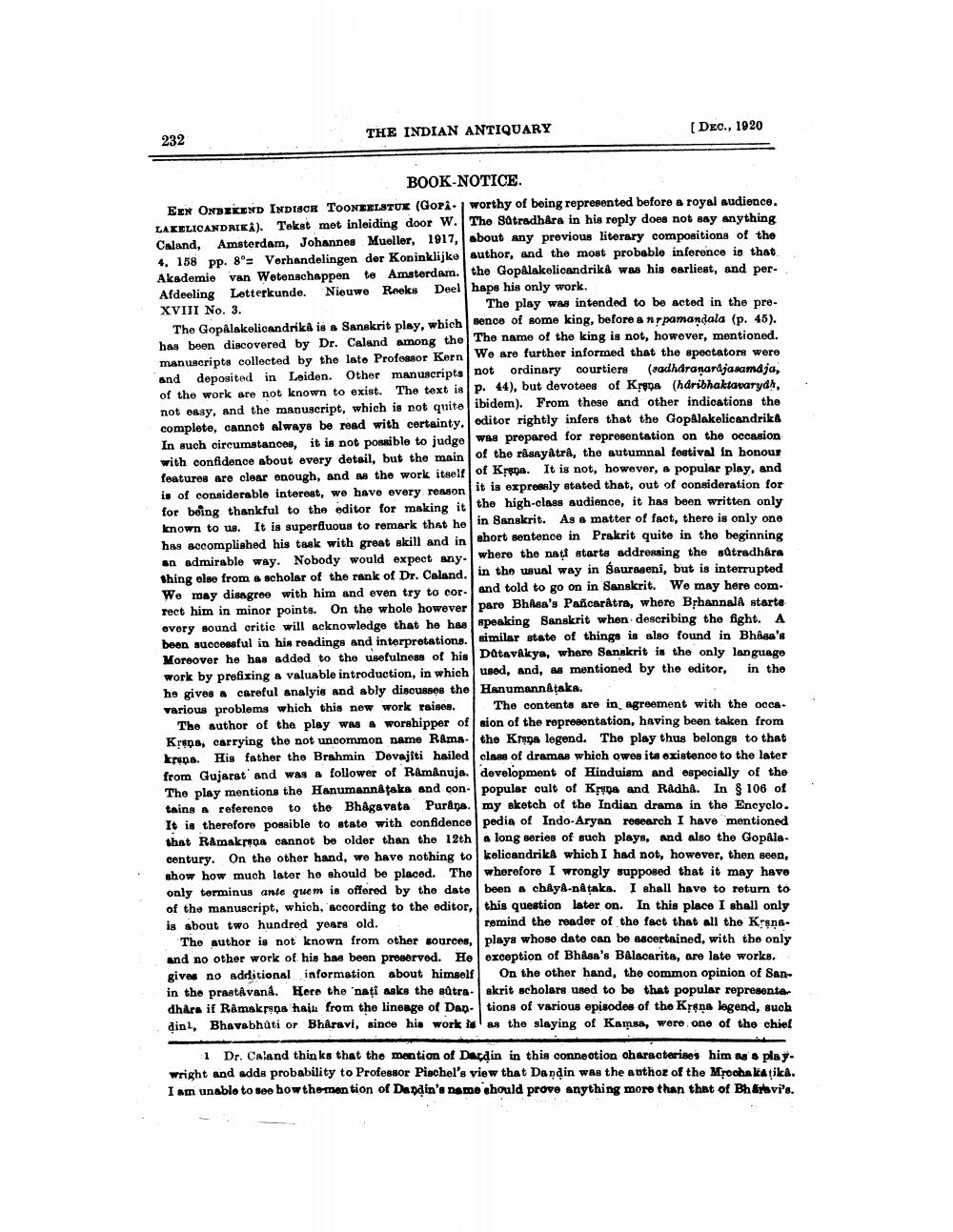________________
THE INDIAN ANTIQUARY
232
(DEC., 1920
BOOK-NOTICE. EEN ONBEKEND INDISCH TOONEELSTUX (Gori. worthy of being represented before a royal audience. LAEELICANDRIKA). Tekst met inleiding door W. The Stradhara in his reply does not say anything Caland, Amsterdam, Johannes Mueller, 1917, about any previous literary compositions of the 4. 158 pp. 8° Verhandelingen der Koninklijke author, and the most probablo inference is that Akademie van Wetenschappen te Amsterdam. the Gopalakalioandrika was his earliest, and per. Afdeeling Letterkunde. Nieuwe Reeks Deel haps his only work. XVII No. 3.
The play was intended to be acted in the preThe GopAlakelicandrika is a Sanskrit play, which sence of some king, before anpamandala (p. 45). has been discovered by Dr. Caland among the The name of the king is not, however, mentioned. manuscripts collected by the late Professor Kern We are further informed that the spectators were and deposited in Leiden. Other manuscripts not ordinary courtiers (sadhdranardjasamdja, of the work are not known to exist. The text is p. 44), but devotees of Kred (hdribhaktawarydh. not only, and the manuscript, which is not quito ibidem). From these and other indications the complete, cannot always be read with certainty.oditor rightly infers that the Gopalakelioandrika In such circumstances, it is not possible to judge was prepared for representation on the occasion with confidence about every detail, but the main of the ranyátra, the autumnal festival in honour features are clear enough, and as the work itseltof Kroa. It is not, however, . popular play, and is of considerable interest, we have every reason it is exprowly stated that, out of consideration for for being thankful to the editor for making it the high-class audience, it has been written only known to us. It is superfluous to remark that he in Sanskrit. As a matter of fact, there is only ono has accomplished his task with great skill and in short sentence in Prakrit quite in the beginning an admirable way. Nobody would expect anywhere the nat starta addressing the stradhera thing else from a scholar of the rank of Dr. Caland. in the usual way in Sauraseni, but is interrupted Wo may disagree with him and even try to cor- and told to go on in Sanskrit. We may here comrect him in minor points. On the whole however paro BhAsa's Pafcarátra, where Bhannal starte overy sound critic will acknowledge that he has speaking Sanskrit when describing the fight. A been successful in hin readings and interpretations. similar state of things is also found in Bha's Moreover he has added to the usefulness of his
Datav kya, where Sanskrit is the only language work by prefixing a valuable introduction, in which used, and, as mentioned by the editor, in the ho gives careful analyis and ably discusses the Hanumannataka. various problems which this new work raises. The contents are in agreement with the occa
The author of the play was a worshipper of sion of the representation, having been taken from Kropa, carrying the not uncommon name R&ma- the Kripa legend. The play thus belongs to that kros. His father the Brahmin Dovaj ti hailed class of dramas which owes its oxistence to the later from Gujarat and was follower of Ramanuja. development of Hinduism and especially of the The play mentions the Hanumann&taka and con- popular cult of Krpa and Radh. In § 106 of tains reference to the Bhagavata Purana. my sketch of the Indian drama in the Encyclo. It is therefore possible to state with confidence pedia of Indo-Aryan research I have mentioned that Ramakrina cannot be older than the 12th a long series of such plays, and also the Gopalacentury. On the other hand, we have nothing to kolicandrika which I had not, however, then seen, show how much later he should be placed. The wherefore I wrongly supposed that it may have only terminus ante quem is offered by the date been cháyA-nataka. I shall have to return to of the manuscript, which, according to the editor, this question later on. In this place I shall only is about two hundred years old.
remind the reader of the fact that all the KronsThe author is not known from other sources, plays whose date can be ascertained, with the only and no other work of his has been preserved. He exception of Bhasa's Balacarita, are late works. gives no additional information about himself On the other hand, the common opinion of Sanin the praatavana. Here the nati asks the stre-skrit scholars used to be that popular representa dhara if Ramakrips hail from the lineage of Dan. tions of various episodes of the Krena legend, such dinl, Bhavabhūti or Bharavi, since his work w as the slaying of Kamsa, were one of the chief
1 Dr. Caland thinks that the mention of Dardin in this connection characterises him play. wright and adda probability to Professor Pischel's view that Dandin was the author of the Myocha katikA. I am unable to see how the man tion of Daddin's name should prove anything more than that of Bh Bravilo.




